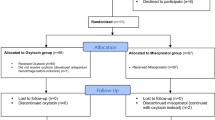Abstract
The objective of this study was to document the complications, outcomes and causes of obstetric fistulas in East African women who underwent first-time surgical repair. Attention was also paid to social background and characteristics of the patients. Data were collected prospectively from patients operated on in the period from January 2001 to August 2003. Only patients who received first-time surgery and whose fistula had been caused by obstructed labour were included in the study. Eight hundred eighty-eight patients received fistula-related surgical treatment. A total of 639 of the patients with 647 fistulas underwent first-time repair. Our study comprised the 581 (90.9%) patients whose fistulas had been caused by obstructed labour. Their mean age was 27 years, 70% were shorter than 156 cm, and 30.8% had completed primary education. In 45.1%, the fistula patient was primigravida; perinatal survival was 11.5%. Mean duration between onset of the fistula and surgical treatment was 36.4 months. In 40.6%, the fistula patients lived separated from their partner. Overall closure rate of the fistulas was 93.8%. No variables were identified for success of closure using a multivariate analysis. Patients operated on within 3 months had a slightly better surgical outcome 93.9% versus 87.0%. Our population of East African obstetric fistula patients shared most of the demographic and physical features of fistula patients in the rest of the African continent. Early surgical repair (<3 months) seemed to improve the surgical outcome and can be expected to restore the social status of the patient.

Similar content being viewed by others
References
Lee RA, Symmonds RE, Williams TJ (1988) Current status of genitourinary fistula. Obstet Gynecol 72(3 Pt 1):313–319
Eilber KS, Kavaler E, Rodriguez LV, Rosenblum N, Raz S (2003) Ten-year experience with transvaginal vesicovaginal fistula repair using tissue interposition. J Urol 169(3):1033–1036
Wall LL, Arrowsmith SD, Briggs ND, Lassey A (2002) Urinary incontinence in the developing world: the obstetric fistula. Incontinence, Health Publication [Internet] [cited 2006 August]; Available from: www.fistulafoundation.org/pdf/UIDW.pdf
Tahzib F (1983) Epidemiological determinants of vesicovaginal fistulas. Br J Obstet Gynaecol 90(5):387–391
Arrowsmith SD (1994) Genitourinary reconstruction in obstetric fistulas. J Urol 152(2 Pt 1):403–406
Wall LL, Karshima JA, Kirschner CA, Arrowsmith SD (2004) The obstetric vesicovaginal fistula: characteristics of 899 patients from Jos, Nigeria. Am J Obstet Gynecol 190(4):1011–1019
Hilton P, Ward A (1998) Epidemiological and surgical aspects of urogenital fistulae: a review of 25 years’ experience in southeast Nigeria. Int Urogynecol J Pelvic Floor Dysfunct 9(4):189–194
Waaldijk K (2004) The immediate management of fresh obstetric fistulas. Am J Obstet Gynecol 191(3):795–799
Elkins TE (1994) Surgery for the obstetric vesicovaginal fistula: a review of 100 operations in 82 patients. Am J Obstet Gynecol 170(4):1108–1118; discussion 1118–1120
Kelly J (1995) Ethiopia: an epidemiological study of vesico-vaginal fistula in Addis Ababa. World Health Stat Q 48(1):15–17
Waaldijk K (1994) Step-by step surgery of vesicovaginal fistulas. Campion Press Limited, Edinburgh
Elkins TE, Drescher C, Martey JO, Fort D (1988) Vesicovaginal fistula revisited. Obstet Gynecol 72(3 Pt 1):307–312
Waaldijk K (1995) Surgical classification of obstetric fistulas. Int J Gynaecol Obstet 49(2):161–163
Moir JC (1967) The vesico-vaginal fistula, (Chap. 11) 2nd edn. Balliere Tindall and Cassell, London, p 134
Waaldijk K, Elkins TE (1994) The obstetric fistula and peroneal nerve injury: an analysis of 947 consecutive patients. Int Urogynecol J 5:12–14
Harrison KA (1979) Nigeria. Lancet 2(8154):1229–1232
Ampofo EK, Omotara BA, Otu T, Uchebo G (1990) Risk factors of vesico-vaginal fistulae in Maiduguri, Nigeria: a case-control study. Trop Doct 20(3):138–139
Thaddeus S, Maine D (1994) Too far to walk: maternal mortality in context. Soc Sci Med 38(8):1091–1110
WHO (1994) partograph cuts complications of labour and childbirth. Safe Mother (15):10
Rehan NE, Tafida DS (1979) Birth weight of Hausa infants in Northern Nigeria. Br J Obstet Gynaecol 86(6):443–449
Rehan NE (1982) Sex ratio of live-born Hausa infants. Br J Obstet Gynaecol 89(2):136–141
Author information
Authors and Affiliations
Corresponding author
Rights and permissions
About this article
Cite this article
Raassen, T.J.I.P., Verdaasdonk, E.G.G. & Vierhout, M.E. Prospective results after first-time surgery for obstetric fistulas in East African women. Int Urogynecol J 19, 73–79 (2008). https://doi.org/10.1007/s00192-007-0389-6
Received:
Accepted:
Published:
Issue Date:
DOI: https://doi.org/10.1007/s00192-007-0389-6




